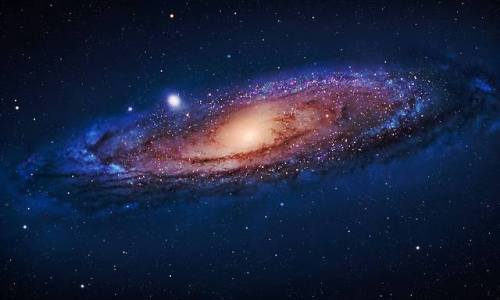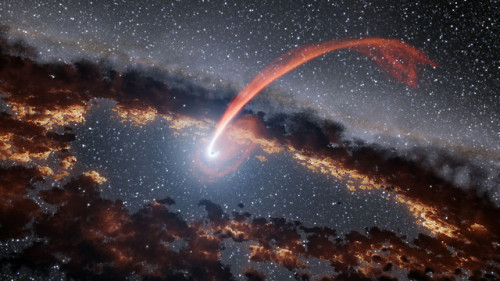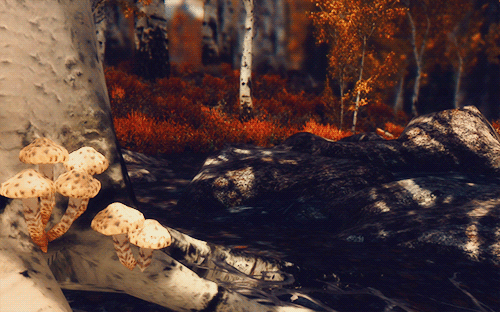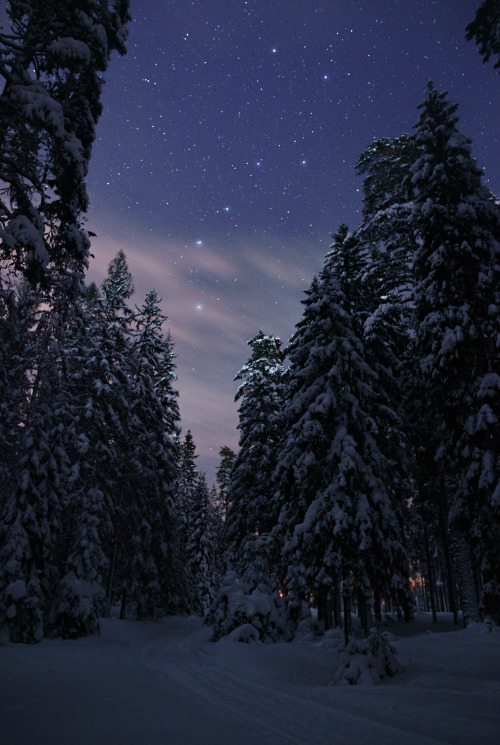Monstrous-mind - The Monster Mind

More Posts from Monstrous-mind and Others
🍂🍁🏔️🌨️🌌

Mark Basarab

The Milky Way’s long-lost sibling finally found
Scientists at the University of Michigan have deduced that the Andromeda galaxy, our closest large galactic neighbor, shredded and cannibalized a massive galaxy two billion years ago.
Even though it was mostly shredded, this massive galaxy left behind a rich trail of evidence: an almost invisible halo of stars larger than the Andromeda galaxy itself, an elusive stream of stars and a separate enigmatic compact galaxy, M32. Discovering and studying this decimated galaxy will help astronomers understand how disk galaxies like the Milky Way evolve and survive large mergers.
This disrupted galaxy, named M32p, was the third-largest member of the Local Group of galaxies, after the Milky Way and Andromeda galaxies. Using computer models, Richard D'Souza and Eric Bell of the University of Michigan’s Department of Astronomy were able to piece together this evidence, revealing this long-lost sibling of the Milky Way. Their findings were published in Nature Astronomy.
source
😮💨📖📚📘📙📗

kitchen ghosts
🔭🌃🌌🛰

Astronomers Detect Matter Falling into Black Hole
University of Leicester’s Professor Ken Pounds and co-authors report the detection of matter falling into a black hole at 30% of the speed of light.

It is now well established that a supermassive black hole lies in the center of most galaxies, and further that it accretes matter through a disk.
With sufficient matter (interstellar gas clouds or even isolated stars) falling into the black hole, these can become extremely luminous, and are seen as a quasar or active galactic nucleus (AGN).

The orbit of matter around the black hole is often assumed to be aligned with the rotation of the black hole, but there is no compelling reason for this to be the case. In fact, the reason we have summer and winter is that the Earth’s daily rotation does not line up with its yearly orbit around the Sun.
Until now it has been unclear how misaligned rotation might affect the in-fall of matter. This is particularly relevant to the feeding of supermassive black holes since matter can fall in from any direction.

Using data from ESA’s XMM-Newton X-ray Observatory, Professor Pounds and colleagues looked at X-ray spectra from PG1211+143, a Seyfert galaxy (characterized by a very bright AGN resulting from the presence of the massive black hole at its nucleus) located in the constellation Coma Berenices, about one billion light-years away.

The team found the spectra to be strongly red-shifted, showing the observed matter to be falling into PG1211+143’s black hole at the enormous speed of 30% of the speed of light, or around 62,000 miles per second (100,000 km per second).
The gas has almost no rotation around the black hole, and is detected extremely close to it in astronomical terms, at a distance of only 20 times the black hole’s size (its event horizon, the boundary of the region where escape is no longer possible).
“The galaxy we were observing with XMM-Newton has a 40-million-solar-mass black hole which is very bright and evidently well fed,” Professor Pounds said.

“Indeed some 15 years ago we detected a powerful wind indicating the black hole was being over-fed. While such winds are now found in many active galaxies, PG1211+143 has now yielded another ‘first,’ with the detection of matter plunging directly into the black hole itself.”
“We were able to follow an Earth-sized clump of matter for about a day, as it was pulled towards the black hole, accelerating to a third of the velocity of light before being swallowed up by the hole.” source
🍁🍂



The Rift.
🍃🌄🍂🍁🐈

Huck

Momma Oryctrodromeus stays in the burrow with her babies while Papa goes outside to tell the stinky mammal to get off their lawn.
Read more about them here
🍁🍂🎃🍂🍁🌬🍃🐈🌄

Hello September. May you the first of so many good things to come as the unofficial start to autumn 🍂
🔭🌌☄️🪐

The Running Chicken Nebula comprises several clouds, all of which we can see in this vast image from the VLT Survey Telescope (VST), hosted at ESO’s Paranal site. This 1.5-billion pixel image spans an area in the sky of about 25 full Moons. The clouds shown in wispy pink plumes are full of gas and dust, illuminated by the young and hot stars within them.
Credit: ESO
🔭🌃🌌🪐🍁🍂⛄

Under the big dipper
by: Mikhail Reva
-
 nymphadorasblog liked this · 3 months ago
nymphadorasblog liked this · 3 months ago -
 andron-temporis reblogged this · 3 months ago
andron-temporis reblogged this · 3 months ago -
 officiallordvetinari liked this · 3 months ago
officiallordvetinari liked this · 3 months ago -
 seeby28 reblogged this · 3 months ago
seeby28 reblogged this · 3 months ago -
 haiimrowie reblogged this · 3 months ago
haiimrowie reblogged this · 3 months ago -
 fogpowers reblogged this · 3 months ago
fogpowers reblogged this · 3 months ago -
 featheredfriend reblogged this · 3 months ago
featheredfriend reblogged this · 3 months ago -
 buffalocaniac reblogged this · 4 months ago
buffalocaniac reblogged this · 4 months ago -
 takemyadvice-dontlistentome reblogged this · 4 months ago
takemyadvice-dontlistentome reblogged this · 4 months ago -
 lemoncat101 reblogged this · 4 months ago
lemoncat101 reblogged this · 4 months ago -
 lemoncat101 liked this · 4 months ago
lemoncat101 liked this · 4 months ago -
 skyhon reblogged this · 4 months ago
skyhon reblogged this · 4 months ago -
 thebutterfreeeffect liked this · 4 months ago
thebutterfreeeffect liked this · 4 months ago -
 jembarrassment reblogged this · 4 months ago
jembarrassment reblogged this · 4 months ago -
 hex-actly reblogged this · 4 months ago
hex-actly reblogged this · 4 months ago -
 surroundedbybooks reblogged this · 4 months ago
surroundedbybooks reblogged this · 4 months ago -
 rangerofthemojave reblogged this · 4 months ago
rangerofthemojave reblogged this · 4 months ago -
 red-gyarados reblogged this · 4 months ago
red-gyarados reblogged this · 4 months ago -
 bad-wulf reblogged this · 5 months ago
bad-wulf reblogged this · 5 months ago -
 surrealpanda liked this · 5 months ago
surrealpanda liked this · 5 months ago -
 tiny-memer reblogged this · 5 months ago
tiny-memer reblogged this · 5 months ago -
 dumb-starbucks liked this · 5 months ago
dumb-starbucks liked this · 5 months ago -
 amplexadversary reblogged this · 5 months ago
amplexadversary reblogged this · 5 months ago -
 redmegarex reblogged this · 5 months ago
redmegarex reblogged this · 5 months ago -
 irtoom liked this · 5 months ago
irtoom liked this · 5 months ago -
 corruptedchangeling reblogged this · 5 months ago
corruptedchangeling reblogged this · 5 months ago -
 digic300 reblogged this · 5 months ago
digic300 reblogged this · 5 months ago -
 raezing liked this · 5 months ago
raezing liked this · 5 months ago -
 kittycatdancer liked this · 5 months ago
kittycatdancer liked this · 5 months ago -
 cake-of-awesome reblogged this · 5 months ago
cake-of-awesome reblogged this · 5 months ago -
 python-nebula reblogged this · 5 months ago
python-nebula reblogged this · 5 months ago -
 python-nebula liked this · 5 months ago
python-nebula liked this · 5 months ago -
 teyn-exe liked this · 5 months ago
teyn-exe liked this · 5 months ago -
 insertabetterusernamehere liked this · 5 months ago
insertabetterusernamehere liked this · 5 months ago -
 junkmailmusubi reblogged this · 5 months ago
junkmailmusubi reblogged this · 5 months ago -
 a-thief-with-patience liked this · 5 months ago
a-thief-with-patience liked this · 5 months ago -
 aroace-nut-case liked this · 5 months ago
aroace-nut-case liked this · 5 months ago -
 d3w-dr0p5s liked this · 5 months ago
d3w-dr0p5s liked this · 5 months ago -
 cheese-in-space reblogged this · 5 months ago
cheese-in-space reblogged this · 5 months ago -
 cubescop liked this · 5 months ago
cubescop liked this · 5 months ago -
 taytumtowne reblogged this · 5 months ago
taytumtowne reblogged this · 5 months ago -
 taytumtowne liked this · 5 months ago
taytumtowne liked this · 5 months ago -
 somebodynew1guess reblogged this · 5 months ago
somebodynew1guess reblogged this · 5 months ago -
 thearcanecat liked this · 5 months ago
thearcanecat liked this · 5 months ago -
 jasperthejester reblogged this · 5 months ago
jasperthejester reblogged this · 5 months ago -
 jasperthejester liked this · 5 months ago
jasperthejester liked this · 5 months ago -
 cloffmoff liked this · 5 months ago
cloffmoff liked this · 5 months ago -
 the-sun-personified reblogged this · 5 months ago
the-sun-personified reblogged this · 5 months ago -
 the-sun-personified liked this · 5 months ago
the-sun-personified liked this · 5 months ago -
 sleepinginpanic liked this · 5 months ago
sleepinginpanic liked this · 5 months ago
My ambition is handicapped by laziness. -C. Bukowski Me gustan las personas desesperadas con mentes rotas y destinos rotos. Están llenos de sorpresas y explosiones. -C. Bukowski. I love cats. Born in the early 80's, raised in the 90's. I like Nature, Autumn, books, landscapes, cold days, cloudy Windy days, space, Science, Paleontology, Biology, Astronomy, History, Social Sciences, Drawing, spending the night watching at the stars, Rick & Morty. I'm a lazy ass.
222 posts